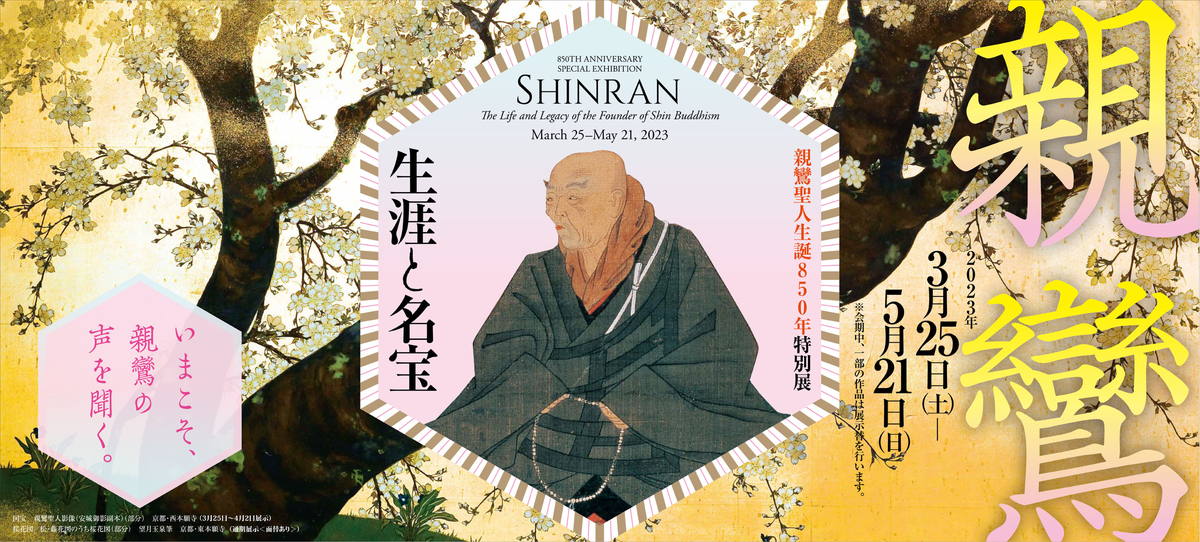- TOP
- Exhibitions
- Special Exhibitions
- 850th Anniversary Special Exhibition Shinran: The Life and Legacy of the Founder of Shin Buddhism
General Information
- Exhibition Title
-
850th Anniversary Special Exhibition
Shinran: The Life and Legacy of the Founder of Shin Buddhism
- Period
-
March 25–May 21, 2023
The exhibition has two installations:
Part I: March 25–April 23, 2023
Part II: April 25–May 21, 2023
Some artworks may be rotated during the exhibition period.
- Venue
-
Kyoto National Museum, Heisei Chishinkan Wing
- Closed
-
Mondays
- Special Exhibition Hours
-
9:00 a.m.–5:30 p.m. (Entrance until 5:00 p.m.)
- Special Exhibition Admission
-
Adult 1,800 yen
(1,600 yen)University Student 1,200 yen
(1,000 yen)High School Student 700 yen
(500 yen)- Discounted prices displayed in ( ) are for advanced ticket purchases, available for purchase January 25 to March 24, 2023.
- Information on advanced ticket purchases and sales locations is provided on the exhibition’s official website (Japanese only).
- Please show student ID for student admission.
- Admission is free for junior high school students and other youths age 0–15, visitors with disabilities and one caretaker. Please show ID.
- Admission is reduced by 500 yen for Campus Members (including faculty) able to produce ID.
- Audio Guide
-
- Fee
- 650 yen (includes tax)
- Time
- approx. 40 min
- Languages
- Japanese, English
- Rental Start Times
- 9:00 a.m.-5:00 p.m. (Headsets should be returned by 5:30 p.m.)
- Catalogue
-
For availability and purchasing information, see Exhibition Catalogues and Related Publications
- Organized by
-
Kyoto National Museum; The Asahi Shimbun Company; NHK Kyoto Station; NHK Enterprises, Inc., Osaka Branch Office
- With the special cooperation of
-
Shinshu Kyodan Rengo
- With the support of
-
Dai Nippon Printing Co., Ltd.; Kyoto Women's University
- Special Exhibition Official Website
- The official exhibition website is no longer in service.
Description of Exhibition
Born in Kyoto, Master Shinran (Shinran Shōnin, 1173–1262) was the founder of the Jōdo Shinshū, or Shin school of Buddhism. Shinran was ordained at the age of nine, entering the monastery on Mount Hiei as a novice monk to study and practice Buddhism of the Tendai school. Upon descending from Mount Hiei at age twenty-nine, he became a disciple of the Pure Land Buddhist priest Hōnen, who was living in Kyoto at the time. Through Hōnen, he encountered the nenbutsu teaching of the Original Vow of Amida Buddha (hongan nenbutsu)—a doctrine of equal salvation for all people through the repeated chanting of the buddha’s name. Shinran’s activities were temporarily hampered when Hōnen’s nenbutsu movement was banned in 1207, at which time Shinran was stripped of his clerical status and exiled to Echigo (present-day Niigata Prefecture). He was finally pardoned in 1211 and moved to the Kanto region, where he spent over two decades spreading the teaching. Eventually Shinran returned to Kyoto and spent his last years composing and refining his many writings including his magnum opus The True Teaching, Practice, Faith, and Realization of the Pure Land Way (Ken jōdo shinjitsu kyōgyōshō monrui; popularly known as Kyōgyōshinshō) and hymns in Japanese (wasan). Shinran’s earnest devotion to the study and dissemination of his understanding of Buddhism over his ninety years of life continues to fascinate people to this day.
Shinran: The Life and Legacy of the Founder of Shin Buddhism, held in commemoration of the 850th anniversary of Shinran’s birth, traces this religious leader’s life of seeking and teaching in Kyoto, his place of birth and death, through various treasures owned by branch temples of Shin Buddhism. With the support of these temples, we have brought together an assemblage of historic works related to Shinran, including myōgō (calligraphed icons of Amida Buddha’s Sacred Name), books, and letters written in his own hand. This exhibition also explores this founder’s life and legacy through wooden statues, portraits, and illustrated handscrolls.
![National Treasure. Portrait of Master Shinran, Known as Anjō no goei (“Anjō Portrait”), (Reproduction of 1255 Version). Hymns and inscriptions on reverse by Rennyo. Nishi Hongwan-ji Temple, Kyoto. [on view March 25 –April 2, 2023]](/jp/exhibitions/assets/special/shinran_2023/shinran_20230325_2.jpg)
National Treasure
Portrait of Master Shinran, Known as Anjō no goei (“Anjō Portrait”), (Reproduction of 1255 Version)
Hymns and inscriptions on reverse by Rennyo
Nishi Hongwan-ji Temple, Kyoto
[on view March 25 –April 2, 2023]
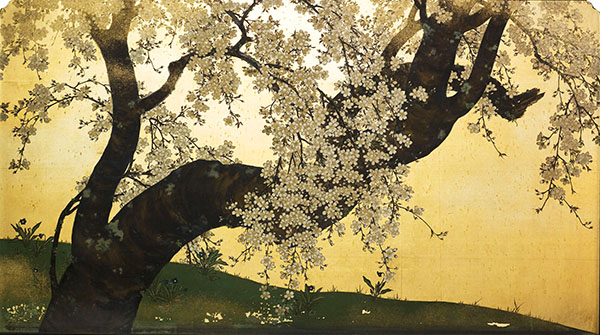
Cherry Blossoms; Pine and Wisteria
By Mochizuki Gyokusen
Higashi Hongan-ji Temple, Kyoto
I. Shinran’s Guiding Light: The Seven Masters for Shin Buddhism
The vast tradition of Buddhism is characterized as having 84,000 teachings. Not only is the Chinese Buddhist canon comprised of over five thousand volumes of scriptures, but it is also said that the number of buddhas equals the number of grains of sand of the Ganges River. In order to articulate the teachings and orthodoxy that defined their beliefs and practices, individual schools sought to identify sets of three principal scriptures and a particular lineage of doctrinal transmission stretching from the Historical Buddha Shakyamuni to the present.
This section introduces the central buddha of Shin Buddhism, the Buddha Amida (Skt: Amitābha, Buddha of Infinite Light; also known as Amitāyus, Buddha of Infinite Life), and the foundation of its teaching in the three Pure Land sutras that focus on this buddha—the Sutra on the Buddha of Infinite Life (J: Muryōju kyō), the Sutra on the Contemplation of the Buddha of Infinite Life (J: Kanmuryōju kyō), and the Amitābha Sutra (J: Amida kyō). Also examined here is the lineage that Shinran established through the Seven Pure Land Patriarchs. These are identified as the Indian thinkers Nāgārjuna (ca. 2nd–3rd century) and Vasubandhu (ca. 5th century); the Chinese scholar monks Tanluan (476–542), Daochuo (562–645), and Shandao (613–681); and the Japanese priests Genshin (942–1017) and Hōnen (Genkū, 1133–1212). Shinran revered these seven figures, instructing: “Only believe in the teachings of these masters.”
![Embroidered Amida (Amitābha) Buddha. Jōshō-ji Temple, Fukui. [on view: March 25–April 23, 2023]](/jp/exhibitions/assets/special/shinran_2023/shinran2023_004_1_3F-1.jpg)
Embroidered Amida (Amitābha) Buddha
Jōshō-ji Temple, Fukui
[on view: March 25–April 23, 2023]
![National Treasure. Commentary on the Contemplation Sutra (J: Kanmuryōju kyō chū). By Shinran. Nishi Hongwan-ji Temple, Kyoto. [on view: March 25–April 30, 2023]](/jp/exhibitions/assets/special/shinran_2023/shinran2023_015_1_3F-1.jpg)
National Treasure
Commentary on the Contemplation Sutra (J: Kanmuryōju kyō chū)
By Shinran
Nishi Hongwan-ji Temple, Kyoto
[on view: March 25–April 30, 2023]
II. The Life of Shinran
Shinran authored many doctrinal texts that preserve his teachings, but he did not share much about his own life. His teachings, however, inspired devotion in many, and after his death several biographies were composed by Shinran’s devoted followers.
This section traces the ninety years of Shinran’s life through biographies in illustrated handscroll format, the earliest of which was compiled by his great grandson Kakunyo (1270–1351) in 1295, thirty-three years after Shinran’s death. These scrolls cover the founder’s birth, his ordination at age nine, his encounter with his teacher Hōnen, his exile to Echigo due to the suppression of Hōnen’s nenbutsu movement, his death on return to Kyoto, and the building of the Ōtani Mausoleum at the site of his grave. Also featured here are objects associated with his life that appear in these biographies.
![Seated Portrait of Master
Shinran. Senju-ji Temple, Mie. [on view: March 25–April 16, 2023]](/jp/exhibitions/assets/special/shinran_2023/shinran2023_036_2_2F-1.jpg)
Seated Portrait of Master Shinran
Senju-ji Temple, Mie
[on view: March 25–April 16, 2023]
![Important Cultural Property. Illustrated Biography of the Master of Hongan-ji Temple [Shinran], Kōei Version, Volume II-2. Inscribed by Kakunyo, illustrated by Sōshun. Higashi Hongan-ji Temple, Kyoto. [on view: May 2–21, 2023]](/jp/exhibitions/assets/special/shinran_2023/shinran2023_040_2_2F-4.jpg)
Important Cultural Property
Illustrated Biography of the Master of Hongan-ji Temple [Shinran] (J: Honganji Shōnin denne), Kōei Version, Volume II-2
Inscribed by Kakunyo, illustrated by Sōshun
Higashi Hongan-ji Temple, Kyoto
[on view: May 2–21, 2023]
III. Shinran and His Disciples
Section 6 of the Lamentations on Divergence (Tannishō), a record of Shinran’s words chronicled by his disciple Yuien (ca. 13th century), recounts that Shinran once said, “I do not have a single disciple.” This statement expresses the founder’s realization that Amida Buddha responds to those who practice the nenbutsu (the recitation of Amida Buddha’s name), making them the disciples of Amida Buddha. In fact, Shinran had many followers, primarily in the Kanto region, who formed branches of his lineage to propagate his teaching throughout Japan.
This section visualizes the spread of Shinran’s teachings through portraits and other images of his disciples. Highlighted here are seated sculptures depicting prominent disciples such as Shōshin, Kenchi, and Ryōkai; images that portray the lineage of succession from Shinran, including portraits of Pure Land masters seated in rows and illustrated succession lineages; and registers of names and locations of Shinran’s disciples.
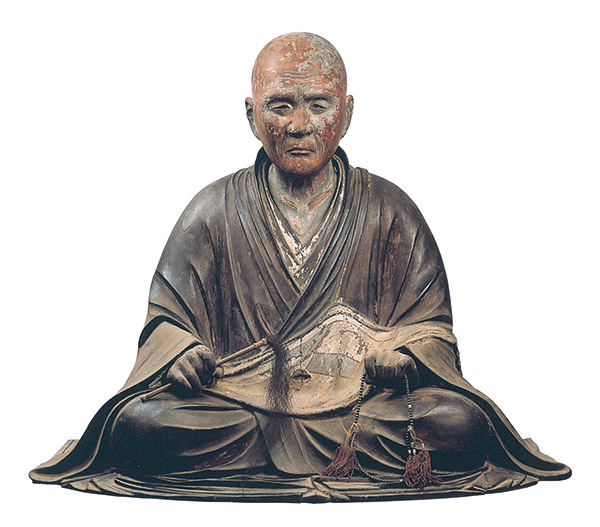
Important Cultural Property
Seated Portrait of Kenchi
Senju-ji Temple, Tochigi
IV. Shinran and Prince Shōtoku
At the age of twenty-nine, Shinran descended from Mount Hiei and secluded himself in Kyoto’s Rokkakudō (Hexagonal Hall). There, on the dawn of the ninety-fifth day of his retreat, Shinran was visited in a dream by the bodhisattva Kuze Kannon (the World-Saving Avalokiteśvara). This dream oracle is described in Shinran’s illustrated biographies, and Shinran’s wife, the nun Esshinni, writes of it in a letter, noting that it prompted her husband to become a disciple of the Pure Land master Hōnen.
Rokkakudō was allegedly founded by Prince Shōtoku (574–622), who is himself considered to be an incarnation of Kuze Kannon, represented in the temple hall by a sculpture of Nyoirin Kannon (Cintāmaṇicakra). Surviving records about Shinran’s dream at Rokkakudō tell us that it signified a major milestone in his life.
This section explores Shinran’s devotion to Prince Shōtoku through sculptural and painted portraits of the prince, passed down in Jōdo Shinshū temples. It also features works associated with Shinran’s dream oracle at Rokkakudō and his Japanese hymns (wasan) dedicated to Shōtoku.
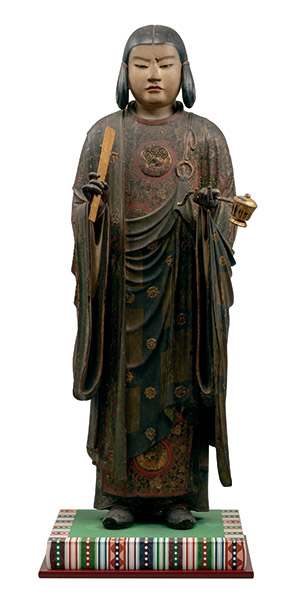
Important Cultural Property
Standing Portrait of Prince Shōtoku as a Filial Son
Zenjū-ji Temple, Ibaraki
Photo courtesy of Kanagawa Prefectural Kanazawa-Bunko Museum
V. The Words of Shinran
Shinran was active until the age of eighty-eight and devoted his life to writing so that he could pass on his teachings. His magnum opus is called The True Teaching, Practice, Faith, and Realization of the Pure Land Way (Ken jōdo shinjitsu kyōgyōshō monrui; known more commonly as Kyōgyōshinshō). The National Treasure Bandō edition of this text is the only surviving copy written in Shinran’s own hand, making it an invaluable historic manuscript. Its many revisions and annotations offer insight into Shinran’s tireless thought process in his final years. His handwriting also expresses his personality, the movements of his brush revealing his unique philosophy and character.
This section introduces the founder’s words through works brushed in his own hand or transcribed by his disciples. They include his handwritten letters to his followers in the Kanto region and his sermons recorded by his disciples. These works provide a close look at the man who continues to inspire and captivate many to this day.
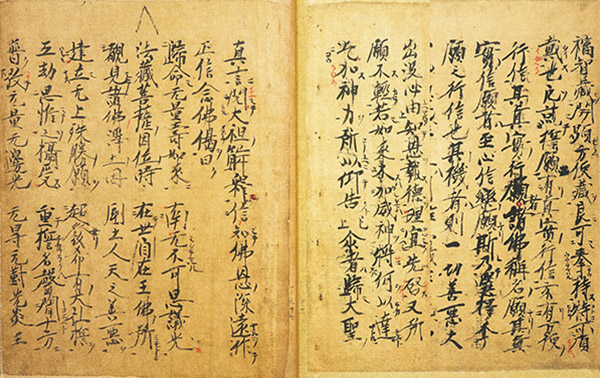
National Treasure
On Teaching, Practice, Faith, and Realization (J: Kyōgyōshinshō), Bandō Version
By Shinran
Higashi Hongan-ji Temple, Kyoto
VI. The Treasures of Shin Buddhism: Wall Paintings and Calligraphic Works
Shinran’s teachings attracted and inspired many, and his disciples and followers went on to form Jōdo Shinshū branch schools throughout Japan. By the Warring States period (ca. 15th–16th centuries), the organizations and systems established by these groups had evolved into a large religious order. The temples of Shin Buddhism, in addition to passing down religious treasures directly associated with Shinran’s teachings, have also preserved numerous secular artworks.
This section presents outstanding works that have been handed down in Kyoto, primarily wall paintings that have adorned temple halls and works of calligraphy that reflect the sophisticated tastes of the capital’s court culture.
![National Treasure. Anthology of Thirty-Six Poets (J: Sanjūrokunin kashū). Poems by Mibu no Tadami (Tadami shū). Nishi Hongwan-ji Temple, Kyoto. [on view: May 2–21, 2023]](/jp/exhibitions/assets/special/shinran_2023/shinran2023_167_6_1F-5.jpg)
National Treasure
Anthology of Thirty-Six Poets (J: Sanjūrokunin kashū)
Poems by Mibu no Tadami (Tadami shū)
Nishi Hongwan-ji Temple, Kyoto
[on view: May 2–21, 2023]
VII. The Legacy of Shinran: Visual Expressions of Myōgō, the Sacred Name of Amida Buddha
In addition to wooden statues and paintings of Amida Buddha, another principal image of the Shin Buddhist tradition is the myōgō (Sacred Name), a religious icon comprising a written phrase in praise of Amida Buddha. Variations include the ten-character myōgō, “I take refuge in the Tathāgata of Unobstructed Light in the Ten Directions” (Kimyō Jinjippō Mugekō Nyorai), the nine-character myōgō, “I entrust myself to the Unfathomable Radiant Tathāgata” (Namu Fukashigi Kō Nyorai), the eight-character myōgō, “I entrust myself to the Unfathomable Radiant Buddha” (Namu Fukashigi Kō Butsu), and the six-character myōgō, “I entrust myself to Amitābha Buddha” (Namu Amida Butsu). These particular linguistic forms are the basis of ritual chanting of Amida Buddha’s Sacred Name, and Shinran specifically taught that the practice of reciting the nenbutsu constituted expression of the actual inner workings of Amida that actively leads people to salvation. At the heart of Shinran’s efforts over his lifetime of ninety years, through his reception of the traditions of the Seven Pure Land Patriarchs of India, China, and Japan, and through his own numerous writings, letters, and sermons, was the dissemination of this Sacred Name.
This last section on Shinran’s legacy presents examples of myōgō brushed in the founder’s own hand alongside portraits of the founder.
![Six-Character Myōgō (Sacred Name of Amitābha Buddha). By Shinran. Nishi Hongwan-ji Temple, Kyoto. [on view: May 2–14, 2023]](/jp/exhibitions/assets/special/shinran_2023/shinran2023_172_7_1F-6.jpg)
Six-Character Myōgō (Sacred Name of Amitābha Buddha)
By Shinran
Nishi Hongwan-ji Temple, Kyoto
[on view: May 2–14, 2023]




